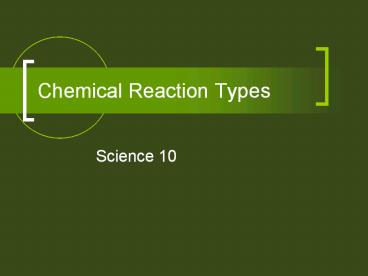Chemical Reaction Types - PowerPoint PPT Presentation
1 / 13
Title:
Chemical Reaction Types
Description:
Chemical Reaction Types Science 10 Exothermic and Endothermic During all chemical reactions, energy is either absorbed or released, in the form of heat, light ... – PowerPoint PPT presentation
Number of Views:181
Avg rating:3.0/5.0
Title: Chemical Reaction Types
1
Chemical Reaction Types
- Science 10
2
Reaction Types
- There are different types of reactions that occur
in science - To figure out the type of reaction you are
dealing with, you need to consider the reactants
(on the left of the arrow) and the products (on
the right of the arrow)
3
Exothermic and Endothermic
- During all chemical reactions, energy is either
absorbed or released, in the form of heat, light,
electricity, or sound - Exothermic reactions energy is released. Ex.
Burning fuel - Endothermic reactions energy is absorbed. Ex.
Cold packs
4
- Physical changes can be exothermic or endothermic
- Ex. Vaporization of water is endothermic
- Ex. Condensation of water is exothermic
5
Law of Conservation of Energy
- Energy can be converted from one form to another,
but the total quantity of energy is the same - Energy is required to break bonds, so products of
an exothermic reaction have less energy in their
bonds than the reactants - Energy is required when bonds form, therefore
products of an endothermic reaction have more
energy in their bonds than the reactants
6
1) Synthesis
- 2 reactants form 1 new single product
- 2Mg(s) O2(g) ? 2MgO(s) thermal energy
- This is exothermic
7
2) Decomposition
- 1 reactant breaks apart to form 2 products
- H2O(l) ? H2(g) O2(g)
8
3) Combustion
- Always a hydrocarbon (made from C and H) mixing
with oxygen to make carbon dioxide and water - CH4 O2 ? CO2 H2O
9
4) Single Displacement
- Element Compound New element New Compound
- Switching the metal most times
- Zn(s) HCl(aq) ? ZnCl2(aq) H2(g)
10
- Fe(s) Cu(NO3)2(aq) ? Cu(s) Fe(NO3)2(aq)
- Metals differ in their reactivity
- A more reactive metal will displace a less
reactive metal in a reaction - Cu(s) Fe(NO3)2(aq) ? no reaction
- Since copper is less reactive (lower on the
activity series) than iron, no displacement will
occur
11
5)Double Replacement Reactions
- 2 compounds give 2 new compounds
- The metals switch places
- Example
- AgNO3(aq) NaCl(aq) ? AgCl(s)
NaNO3(aq)
12
- Also known as a neutralization reaction
- A solid formed when two solutions mix is called a
precipitate - You can tell a double displacement reaction has
occurred if either a precipitate or water forms
as one of the products
13
Identify the "type" for each reaction below, and
balance
- Ca O2 ? CaO
- Br LiI ? LiBr I2
- Al FeBr2 ? AlBr3 Fe
- MgO HCl ? MgCl2 H2O
- C4H10 O2 ? CO2 H2O
- Zn AgCl ? ZnCl2 Ag
- CuBr KCl ? KBr CuCl































